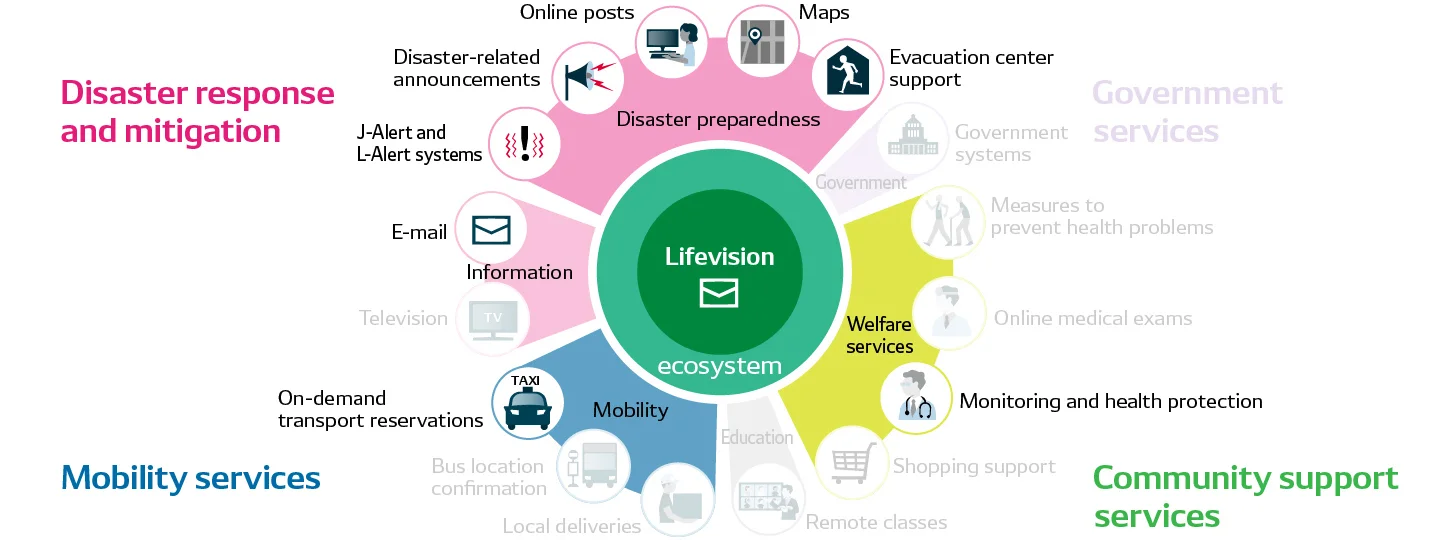

Dec 13, 2021
TECH & DESIGNDigital transformation tailored to local communities, starting from those communities
Creating the “Lifevision”, the community communication platform, in close coordination with local governments
As digitalized, paper-free government operations become more and more commonplace, it has been a challenge to continue providing convenient services to all without leaving anyone behind. Amid these changes, DENSO Corporation’s community communication service platform “Lifevision” is gaining popularity among end users, including senior citizens, for being easy to use, and it is now used by more than 40 local governments. Let’s take a look at the future of the digital revolution (DX) with roots in local communities in outlying regions of Japan.
-
Automotive & Life Solutions Div.Koichi Sugiyama
Koichi Sugiyama joined DENSO in 1998. Initially assigned to gasoline-engine injector development, mass production and production technologies, he was transferred in 2012 to a new business field and began developing “Lifevision” services for use by local governments. Since 2014, Sugiyama has been expanding sales of Lifevision to local governments throughout Japan, and is currently in charge of these operations.
Contents of this article
An information communication service that can truly be used by anyone
— I’m aware that Lifevision is a community information communication service for use by local governments, but I was surprised to learn that an automotive component manufacturer like DENSO was involved in it.
Koichi Sugiyama: DENSO specializes in manufacturing. In the past, we had almost no involvement in products and services delivered directly to end users. However, we believe that mobility as a service (MaaS) and other network-based service approaches will become the norm, and so we will need frameworks for delivering services directly to end users.
We asked ourselves what people in society need most today, and how DENSO can help them. In the end, in view of the potential emergence of smart cities, we settled on the idea of designing a framework that can deliver information from local governments to their citizens.
We created an app for smartphones, tablets and other devices which mainly provides disaster-related notifications and information in written, spoken-audio and image formats, with features related to disaster prevention, welfare, public transport and more as optional additional functions. Lifevision services were launched in 2014, and are now used by more than 40 local governments.
― What are Lifevision’s strengths compared to existing services?
Sugiyama: Lifevision’s features and user interface (UI) were designed based on in-depth studies on UX. Most of existing services tend to offer base systems for major urban centers. As a result, there aren’t many such services available for governments in less populous areas, particularly in regions experiencing depopulation and with large numbers of elderly users.
Generally, it may be considered inefficient to focus business on such places, but we made the bold decision to target the governments of relatively less-populated regions right from the start and to work on proof of concept (PoC) for new functions and services. We felt this approach would enable us to create services more closely tailored to users’ needs and facilitate integration into local communities.

Leveraging experience in mobility products to create a UI that’s easy for anyone to use
— Because your end users are senior citizens, I imagine many of them are reluctant to use smartphones and tablets to access services. What steps have you taken to address this?
Sugiyama: We focused on developing a good UI, working with senior citizens in various regions to determine a wide range of detailed design elements such as an appropriate font size to ensure legibility without using reading glasses, the ideal amount of text on each line and number of menu items, and how many things users could remember when moving from one screen or menu to the next. Service developers tend to keep adding new menu items in order to increase the overall number of functions. But we were careful about this, as we knew that adding too many items would dissuade people from actually using our system.
We also realized that, because many senior citizens have visual impairments which cause them to see as if wearing yellow-tinted sunglasses, reds would appear as browns and other colors could be misconstrued as well. Therefore, we decided to use variations of just one color for menu items and to differentiate them using icons rather than coloring.
In the mobility products field, DENSO is experienced at developing UIs that are easy for anyone to use. We made use of techniques and tricks we learned designing car navigation systems, in-vehicle instrumentation and the like, which enable users to read information quickly and without confusion, in our Web-based services.

― Knowledge of UI and UX design is very important in Japan’s aging society, isn’t it?
Sugiyama: People tend to make generalizations about “senior citizens,” but in fact that age group has become much more used to IT products and technologies in the last decade, and can now use such services in various ways. Therefore, we carry out studies regularly to determine the numbers and types of features that should be integrated into our services.
― In what format are you providing these services?
Sugiyama: Lifevision is operated through Amazon Web Services (AWS). There is only a single Lifevision system, and within it specific space is allocated to each local-government user, which can choose the functions they deem necessary. Furthermore, we use multiple availability zones (AZs; data center clusters within each region) per region to increase the potential of this system.

Creating services together with local governments
— I imagine the services needed vary greatly from government to government. How do you determine the needs of each and reflect them in the services you provide?
Sugiyama: Rather than simply developing the services as governments request, we provide detailed consulting services. Governments add IT services into their operations to increase efficiency and solve problems, but based on our experience, just replacing existing services with IT-tech alternatives is not always ideal.
For example, one local government asked us to create an online shopping site for local stores to help citizens do their shopping. However, many of the local shop owners were very old and had no successor, and their annual turnover was not very large. If we had simply set up an online shopping site, there wouldn’t be enough people using it in the future, and customers who were used to shopping in the actual stores were unlikely to immediately switch over to online purchases instead. We proposed using Lifevision to only showcase products, and then customers make actual purchases by ordering over the phone. Once shop owners and customers got used to this system, then they could transition to an online shopping site.
Another example is an on-demand taxi reservation service, which I’ll talk about in more depth later. With this service, the user makes the reservation online and then waits for the taxi, but with such a simple, impersonal approach some users worry whether the reservation has actually been made. Therefore, we thought it would be best to keep the online reservation function while also offering the option of making reservations over the phone during specified service hours. Over time, this would help people gradually become accustomed to the service.
As an engineer, it’s hard to stay motivated if nobody actually uses the service I helped to develop, whereas it’s motivating to hear words of thanks from users. I think Lifevision’s strength is its hybrid approach—its use of IT to solve certain problems and people to solve others.

― How long is your development cycle for improving existing functions and adding new ones?
Sugiyama: We release regular updates every month to improve functions. When we receive a request for a new function, it usually takes one to six months to develop, depending on the type of function.
— Even when you design services to be user friendly, don’t users who have little or no experience using smartphones and tablets find them difficult to use?
Sugiyama: Whenever we introduce a new service for a local government, we hold orientation meetings in community centers and similar places to explain the services to people who don’t know much about IT. We also jointly developed a game with a university for use in these meetings, which lets people try out a tablet by tapping and flicking things on-screen, having fun as they learn. By playing this game for a month or so, even senior citizens who are not used to such devices can get the hang of it.

― Does everyone who attends the orientation meetings end up using the actual Lifevision services?
Sugiyama: Generally speaking, there were two types of people at the orientations. About 80 percent of participants were inexperienced with IT technologies but, because their children or grandchildren used them, they wanted to try for themselves. The remaining 20 percent had no interest at all in trying because they had no experience and didn’t even have their own mobile phones. The former group were able to start developing a feel for using the devices and apps through practice, and some among the latter group were motivated to try after seeing older participants having fun with the devices.
By the end, there were still a few participants who had no interest in further attempts, which is why we also have a dedicated Lifevision tablet that gives information by audio without needing touch-based user input. We explained to the few remaining holdouts at the end of each meeting that this device could be used like a radio, and encouraged them to try setting one up in their home.

Lifevision tablet gives information by audio and could be used like a radio.
― Do you notice any changes among local governments and users after introducing your services?
Sugiyama: Local governments that adopted our services have made major progress toward paperless operations. For example, in the past they would often distribute information via printed notices, but now they can send it via Lifevision without wasting paper or having staff physically go and pin information on a bulletin board. Lifevision is also used to confirm attendance and absence from meetings as well as other such information, and we have been told that this method, instead of confirming via phone calls and faxes, has greatly reduced workloads in government offices.
The part of the system for which we’ve received the most positive feedback from government users is the photo posting function. In the past, whenever there was a road sinkage incident, the government would receive a phone call from a citizen and then dispatch staff to make an initial investigation of the site. With the Lifevision smartphone app, government employees can view a geotagged photo post of the road problem and immediately dispatch appropriate personnel to fix it.


― Did government organizations, who had mainly used paper-based procedures before Lifevision, struggle to switch over suddenly to a digital alternative?
Sugiyama: Switching everything over all at once would be difficult, which is why we implement a gradual, stage-by-stage transition in most cases. This may entail reducing the number of printed copies of monthly government newsletters to once every three months and seeing how the public reacts, for example. One government in particular, which has made the most progress in this transition than any of our other customers, now only distributes printed information once every six months.
We keep track of active user rates for our system. Under normal circumstances, around 80 percent are active users, which is high. When a natural disaster strikes and related information is sent out to citizens by the government, the active user rates shoots up.
― What features do you plan on adding in the future?
Sugiyama: Citizens have started to view Lifevision as a part of public infrastructure. In addition to existing communication features, governments have increasingly requested Lifevision-based tools that can be used by both the government and citizens, in both directions.
Currently, we are working on an on-demand taxi reservation system. Because information on each household held by the government and each dedicated tablet’s ID are linked, Lifevision allows users to reserve a taxi without having to input personal information first, which is a huge advantage. Although taxi operators are currently requesting cash payment for reservations through this system, in the future we think the service could be improved by enabling payment through existing public billing systems or similar.
Toward a platform that connects businesses
— An information communication system that is easy for senior citizens to use is on the cutting edge of the digital revolution. In the future, do you hope to create a platform for use within smart city frameworks?
Sugiyama: We are currently strengthening ties by collaborating with various business operators via API (application programming interface: a framework that allows one type of service to use functions from another type). Regarding the taxi reservation system I mentioned, many business operators have expressed interest in establishing on-demand transport services in more rural areas. Although MaaS projects may seem daunting in scale, DENSO wants to coordinate the efforts of main-route buses and rail lines with those of local governments to provide transport from the bus stop or train station to the user’s final destination.
— Is your system used in areas such as medicine and nursing care?
Sugiyama: In Japan, online medical examinations have failed to take hold not only due to insufficient dissemination of related systems and frameworks, but also in large part due to resistance among patients. We now realize that the presence or absence of a strong interpersonal relationship between doctor and patient can affect whether or not people choose to use online examination systems, and so we have been looking for a way to build a small-scale online examination system by working together with medical clinics whose doctors have strong relationships of trust with elderly patients.
— You mentioned API collaboration before. What are you doing in this area?
Sugiyama: We have released information about the Web API we use for Lifevision to partner corporations and share data with them.

In the future, we plan to distribute service functions within the Lifevision platform as microservices, and publicize our API to the outside world to enable use of those microservices.

— Companies involved in data usage have been receiving a lot of attention. What are your future plans for business in this area?
Sugiyama: We’re focusing on the movements of people. By collecting data on people’s movements, it is possible to predict user needs for local shops, hospitals and other facilities, and we believe some companies will want to take advantage of these insights when distributing advertisements in the future. Some governments have already distributed tablets to all households in their municipality, and sending ads through these tablets has led to much higher viewing rates than with ads distributed through paper media. This presents a new potential revenue source for local governments, so we are looking at the possibility of working together with such governments and print-based advertisers to increase local-region earnings.
— It seems you have been doing more than simply developing services. You have been considering ideas and opinions from local governments and citizens to create new approaches and frameworks, which is very different from the job of a typical software engineer.
Sugiyama: In server-related operations, we do have some engineers who are constantly developing systems and apps, and I think we provide these members with the best possible development environments. But, as you say, an increasing number of engineers want to communicate with customers and use the information and insights gained to develop new functions.
Rather than using a product-out approach (a development approach based on company standards, without consideration for customer needs) when creating and delivering services, our developers incorporate a market-in approach that considers customer needs during development, and follow this up with speedy verification testing. This type of development environment is a unique one enjoyed by my team, and I think the satisfaction of knowing that one’s work will be useful to customers is a big motivator.
A lot of senior citizens living in remote parts of the country face hard challenges from day to day, and many of them tell us that our services have made life much more convenient. This really encourages us as engineers.
REACTION
Changing your "Can'ts" into "Cans"
Where Knowledge and People Gather.




Leave a comment